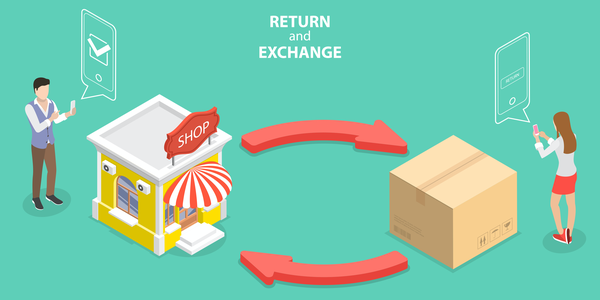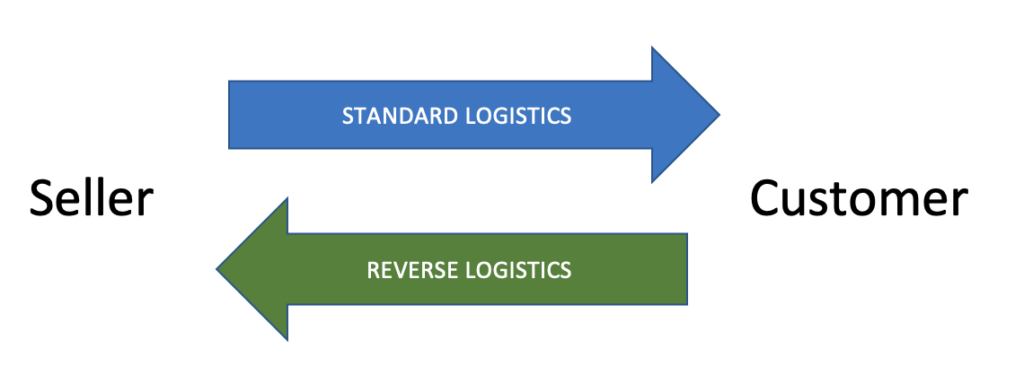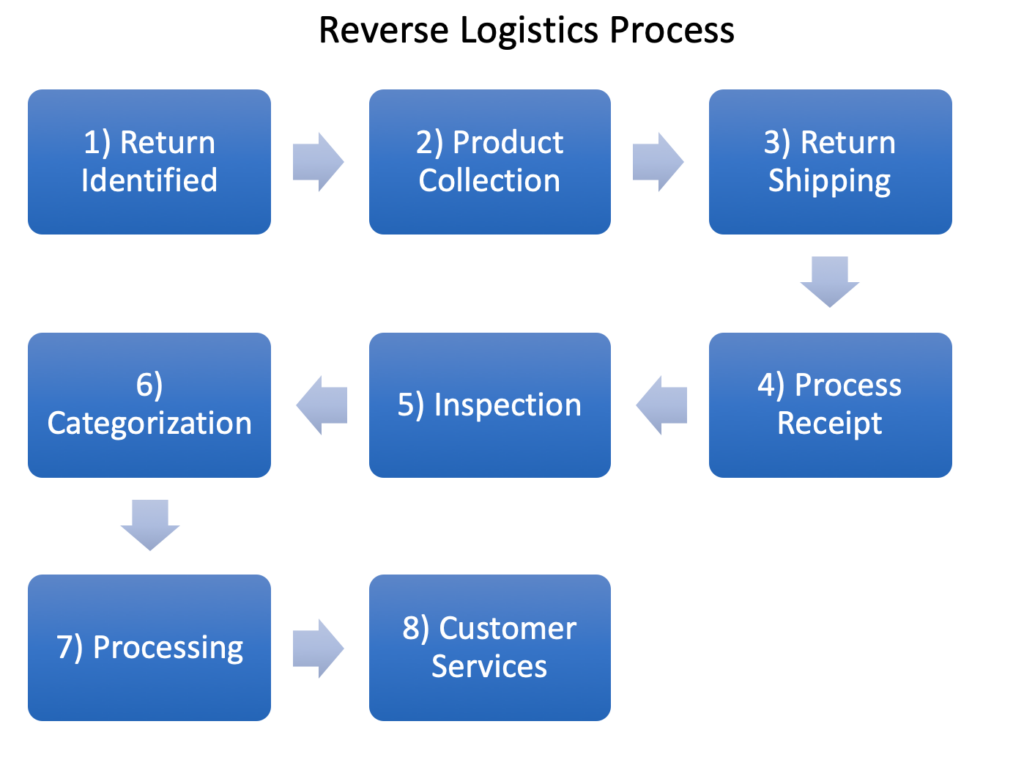
We have probably all experienced the situation where we have bought something online, and when it arrives, things are not quite right.
It might be the wrong size, or maybe functionality is not what we thought it was.
Whatever the problem, we then find ourselves going through the process of returning the item to the business from where we bought it for a refund or replacement.
This logistics flow from the end-user to the company of origin is the process of Reverse Logistics, an increasingly crucial supply chain process. One in which companies need to excel to remain competitive.
In today’s article, we will be looking at the concept of Reverse Logistics; we will be covering:
- What is Reverse Logistics
- Reverse Logistics Examples
- Reverse Logistics Process
- Why is Reverse Logistics Important
- Challenges with Reverse Logistics
- Reverse Logistics Benefits
- How to optimize Reverse Logistics
What is Reverse Logistics
While traditional logistics focuses on the forward flow of material from the producer to the user/customer, reverse Logistics focuses on the flow in the opposite direction, from the point of consumption returning ‘backward’ to the seller.

Reverse Logistics includes:
- Policies
- Process design & implementation
- Control of material
- Customer interaction
- Cost Management
- Inventory management
- Logistics
- Analysis and Inspection
- Recycling, reuse, or disposal.
This flow of goods can include:
- Returned items,
- Inward disposal/recycling of packaging materials,
- Recycling/responsible disposal of materials from previously sold products.
Reverse Logistics is an increasingly critical process as the industry faces higher return rates (either from increased online sales or savvy buyers).
The reverse logistics process has several important deliverables
- A positive customer experience.
- Streamlined policies and processes
- Low costs
- Repeatability
- Reliability
- Cognisant of company capacity constraints
Reverse Logistics Examples
Now we have described its purpose, let’s now look at some examples of Reverse Logistics.
Examples include:
- Customer returns
- Items for repair or refurbishment
- Packaging returns
- Warranty returns
- Returns from distributors
- Recycling of product
- Disposal at the end-of-life
Reverse Logistics Process
The Reverse Logistics process resembles the following diagram:

It typically consists of around eight steps which include:
- Return Signal / Customer Communications
- Product retrieval/collection
- Return Shipping
- Process Receipt
- Inspection of returns
- Categorization (i.e., Recycling, Repairing, Reselling, Discarding, Customer Query)
- Processing
- Support operations/customer communications
As you can see from the earlier examples, there are various reasons for goods to flow back to their origin.
Each reason may require certain facets of the process and specific Logistics arrangements (e.g., warranty returns may require different channels that disposal).
The key in all of this will be managing customer communications providing an effective user experience that is quick, problem-free, and seamless within the companies processes.
Multiple business functions will likely be engaged with the Reverse Logistics process.
For example, customer services may be responsible for interactions with the customer; logistics teams will be responsible for pickup and shipping. Finance teams may be responsible for financial transactions like issuing credits.
This multi-disciplined approach is not straightforward and requires complex planning and execution.
Why Is Reverse Logistics Important?
Reverse Logistics is an essential supply chain process.
There are several key reasons for this:
- Retailers should anticipate high levels of returns (typical online stores suggest 30% returns), (customers buy five items and keep 1)
- Customers expect a simple, effective, and problem-free returns process
- Customers often use prospective returns policies and processes as part of the criteria in selecting products and retailers favoring suppliers that promote straightforward reverse logistics processes
- A poor reverse logistics process can drive buyers to other suppliers
- A poor process drives cost and reduces margin
- A poor customer experience can affect both the individual customer and, in a time of social media and online reviews, the wider brand.
Challenges with Reverse Logistics
Given its importance, it’s perhaps surprising to find that many organizations struggle to design and implement effective processes.
Common issues include:
- Processes are designed as an afterthought, failing to consider likely volume with insufficiently robust processes.
- Organizations fail to estimate the cost of the process effectively, eroding margins.
- The process does not include adequate customer communications leaving consumers frustrated, unsure of the process, and unable to resolve problems.
- Organizations assume processes can be simply outsourced. The reality is that the process can be VERY complex, and without forethought, the quality of the process and user experience is then not in the company’s control.
- Prioritization issues occur in combined (forward & reverse) distribution centers.
- Abuse of Return policies can overload systems.
- Optimizing the process can be costly and require specialist knowledge.
- Costs relating to reverse logistics can be spread throughout the supply chain; addressing them can be complex involving various external contributors to the process.
- The process can be fragmented across many elements of the business resulting in a lack of ownership.
Reverse Logistics Benefits
As we’ve explained in the above sections, reverse logistics has established itself as a critical business process.
The good news is that with a well-thought-out process and effective systems, reverse logistics can add considerable value.
Here are some of the key benefits of reverse logistics:
- Data – an effective Reverse Logistics process enables a business to capture data around the issues that customers experience for utilization in continuous improvement initiatives.
- Reduced costs – A tuned and effective process can help in lowering costs of managing customer returns. For example:
- Reduced warehouse/storage costs
- Reduced logistics costs
- Reduced operating / processing costs
- Customer experience – an effective process can drive not only a superior experience for the customer but one that ultimately drives competition and customer retention.
- Brand image
- Reducing waste – an effective process that enables you to reduce waste.
- Revenue streams – An effective and efficient process allows you to capitalize on revenue opportunities (i.e., resale of goods, revenue from recycling – )
How to Optimize Reverse Logistics
Given the seriousness of the issues above and the ease at which they occur without the appropriate focus or management effort, optimization is key.
Companies can establish this through a number of key themes.
1/ Responsibility for effectiveness rests with senior management
2/ The use of data & analysis to drive the process
3/ Policies and processes are under constant review to ensure effectiveness
4/ Supplier agreements are a key element when planning the Reverse Logistics process (not an afterthought).
5/ Outsourcing used where appropriate and effective.
6/ Automation and use of technology built into processes
7/ Centralized return centers
Summary
Reverse Logistics is an inherent Supply Chain process in every industry.
Reverse Logistics capability is no longer nice to have. It’s a necessity.
To remain competitive, businesses will need to look for innovation that maximizes the customer experience while being both efficient and cost-aware.
The quality of Reverse logistics processes and policies will likely play an ever-increasing role in supply chains as it will underpin the viability of many organizations.
What has your experience been with Reverse Logistics processes? Either as a customer or process administrator? Have you ideas around optimization? or how to improve the customer experience?
As ever, we’d love feedback on the topic; you can reach us on Twitter or via the comments section below.
This article is part of our Supply Chain Guide.